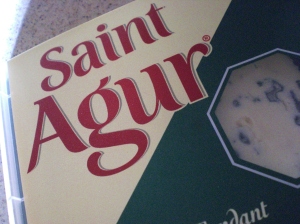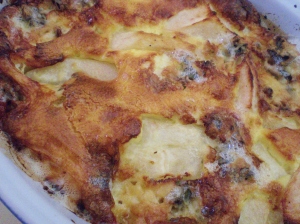Clafoutis, masculine noun (un clafoutis, le clafoutis, des clafoutis) sometimes written clafouti. No single word will translate this. It is a batter mixture, Yorkshire pudding batter to UK readers, pronounced clah-fou-tee (no particular stress, no s heard anywhere). Read on, you will discover more.
Flour (de la farine) has always been a staple of the human diet. Each region of the world, each country has its own varieties of flour and each locality its particular recipe for using it daily, be it bread, chapatis, noodles, tortillas, crêpes or pancakes. We should have great difficulty living without flour and what we make with it is filling, satisfying and very varied.
Clafoutis is generally associated with sweet dishes, a dessert. Cherries usually (un clafoutis aux cerises). In fact if you just say clafoutis to a Frenchman, he will immediately think “cherries”. Batter encircles the fruit, it thickens in cooking and becomes a little chewy, but still creamy, with sweet morsels in every mouthful. You’ll have to wait for summer for the cherry recipe, but I have a winter one for you: clafoutis à la poire et au Saint-Agur (pear and blue cheese clafoutis). This is a savoury dish, a beautiful blend of fruit and cheese, surprisingly light but filling all at once. Easy and quick to make, impressive in its originality. It can be made with wheat flour, but this version, using cornflour, is lighter.
A French expression springs to mind: entre la poire et le fromage – meaning a moment which is propitious for conversation, when, at the end of the meal, one can speak freely.
A word about blue cheese. In France we have several, they are called fromage à pâte persillée (veined cheese). Among them the well-known Roquefort, which is quite seasonal, best from May to September, when it is made with milk from fresh pastures; bleu d’Auvergne, bleu de Bresse, Fourme d’Ambert, Saint-Agur. Use the one you prefer or which you can most easily obtain. I have used Saint-Agur. If you are preparing this for several people, it is better to do it in individual oven dishes. However much you butter your dish, it always sticks, and is impossible to serve. So just eat it straight from the bowl! The proportions are for a main course. If you halve them and use ramekins, it becomes a starter.
For one person you will need:
- 1 pear, just ripe, not over ripe
- 40gr blue cheese
- 1 egg
- 1 heaped tbs cornflour
- 1 pinch salt
- 2 grinds black pepper
- 2tbs fairly liquid cream
- butter to grease the dish
Preparation:
- Pre-heat the oven to 180°.
- Grease an oven dish.
- Peel core and thickly slice the pear into the dish, spreading it evenly.
- Break the egg into a bowl, whisk briefly. Add the salt, pepper and cornflour. Beat the mixture until it is frothy and has no more cornflour lumps. Add the cream and stir.
- Pour this mixture over the pear.
- Dice the blue cheese evenly over the top.
Put into a hot oven for about 25 minutes or until it is golden (doré).
This dish can be eaten cold, or reheated, but is never as delicious as when it has just come out of the oven.
Bon appétit.





Your blog inspires me to cook! I have made the clafouti recipe from Julia Child, but it was a very long time ago.
Great blog entry! I am baking a “clafoutis au fromage” and it was wonderful reading up on this article while it’s cooking away in the oven!